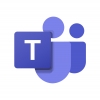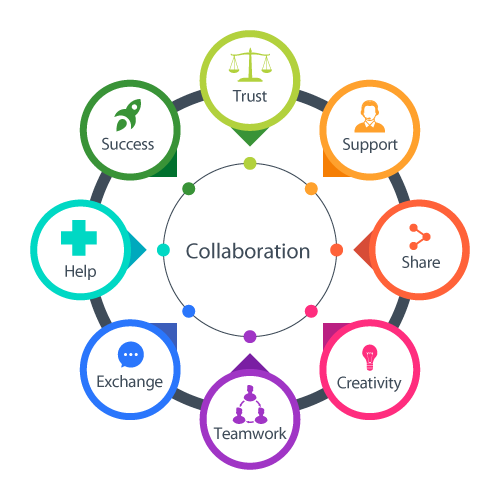Software Tips
What is Collaboration?
Collaboration means working together. It refers to cooperation between individuals or teams or organizations in order to achieve a common goal. The common ground and togetherness are to be promoted and strengthened through collaboration. The cooperation within and between organizations, groups, teams and employees should be based on mutual trust and appreciation as well as support. For joint work, sharing information and access to current data is just as important as exchanging ideas about the tasks at hand. Fruitful collaboration fuels the creativity of the individual. Successful collaboration therefore requires both technical prerequisites and a corresponding attitude or the will to work well together.
Unified Communications and Collaboration (UCC) describes the combination of communication and collaboration technologies. In practice, this means nothing other than that a software platform is available for UCC that combines all communication channels in a single user interface.
What is collaboration software?
The collaboration software provides the technical requirements for collaboration. The software is used for efficient communication and coordination. The tools provide for various communication options such as instant messenger, message board, video chat, etc. and for ideal task distribution with to-do lists and, above all, for file sharing and the fundamentally required single source of trust. As a rule, the collaboration tools are cloud-based.
Advantages of collaboration software
Collaboration independent of time and place
The most important advantage of collaboration tools is the possibility to work independent of location and time. In times of home offices and distributed working groups and teams, it is enormously important to have tools that enable virtual exchange. Team members can call up to-do lists, track the progress of tasks or leave comments, for example.
Productivity improvement
Collaboration tools enable the improvement of the information flow and consequently the knowledge transfer. The advantage of using collaboration tools is that everything is in the context of the respective topics.
Access to information
File sharing and real-time access to information is another major advantage of collaboration tools. Revised documents do not have to be laboriously sent by team members via e-mail, but can be stored centrally and accessed by others. All members with access are always up to date. At the same time, centrally stored documents improve the team's shared knowledge base and are easier to find.
Tips and question suggestions
Further specific criteria and question suggestions for the evaluation of collaboration software:
- How are roles and rights assigned? Are user rights clearly displayed? When selecting a collaboration software, check how the assignment of rights for users is regulated. Can you define what each user can see and edit?
- Ask if event-driven messaging is possible. Does the software offer features to automatically inform about certain project situations. This is particularly useful for larger projects with many people involved, because experience shows that there is always a greater need for information here.
- Make sure that the processing statuses of the people involved in the project or task can be displayed transparently. This promotes an overview of the project or task status.
- Collaboration solutions are mostly cloud-based. For data protection reasons, pay attention to where the server is located!
- Ask if the software includes live streaming capabilities.
- Which language versions does the collaboration software cover? If the software is to ensure smooth collaboration, it is advantageous if as many of the languages spoken in the company as possible can be mapped.
- Since the shared documents should be kept centrally in the cloud, the question is whether the collaboration software includes version management? Storing different document versions can be advantageous for larger projects.
- Can the solution be customized? Can the layout or design be adapted to your company?
- Clarify which authentication methods the software uses. Social collaboration is increasingly being used as a gateway for an IT attack. The login procedures for the tool should be as secure as possible and comply with the company's security standards.
 Unique worldwide: Software for idea and innovation management with SAP technology
Use the creative potential in your team with target software for efficient idea and innovation management. Thanks to the direct use of SAP data and technology, our software offers the best solution for SAP systems worldwide.
Unique worldwide: Software for idea and innovation management with SAP technology
Use the creative potential in your team with target software for efficient idea and innovation management. Thanks to the direct use of SAP data and technology, our software offers the best solution for SAP systems worldwide. teamspace is an enterprise software with which modern teams work together efficiently and successfully. Network your team in the cloud and manage your business processes with practicality and foresight. From the sales process to project planning and billing to the management of customer data.
teamspace is an enterprise software with which modern teams work together efficiently and successfully. Network your team in the cloud and manage your business processes with practicality and foresight. From the sales process to project planning and billing to the management of customer data. The Ready2Go intranet helps you optimize your performance and make you even more successful. Connect familiar applications and data sources with modern collaboration and analysis options. Professional innovations and standardized solutions, such as Microsoft Teams or contract management, have an incredible impact on your teamwork and productivity. Discover all company-relevant information in one platform.
The Ready2Go intranet helps you optimize your performance and make you even more successful. Connect familiar applications and data sources with modern collaboration and analysis options. Professional innovations and standardized solutions, such as Microsoft Teams or contract management, have an incredible impact on your teamwork and productivity. Discover all company-relevant information in one platform. With humbee, teams work together in processes and are always up to date everywhere. No more searching for information - everything is in one place.
Gone are the days of email ping pongs! Depending on your industry, you can adapt humbee to your needs and work together with (selected) employees in complete processes. You can invite external guests to join you (free of charge) if required. Working together has never been more relaxed.
With humbee, teams work together in processes and are always up to date everywhere. No more searching for information - everything is in one place.
Gone are the days of email ping pongs! Depending on your industry, you can adapt humbee to your needs and work together with (selected) employees in complete processes. You can invite external guests to join you (free of charge) if required. Working together has never been more relaxed. Jitsi is a free, open-source video conferencing software that provides a flexible, secure, and easy-to-use platform for online meetings. With Jitsi, users can easily make video and audio calls, share files, and present screen content ...
Jitsi is a free, open-source video conferencing software that provides a flexible, secure, and easy-to-use platform for online meetings. With Jitsi, users can easily make video and audio calls, share files, and present screen content ... Asana is a SaaS work management tool that helps teams centralize tasks, projects, timelines, goals, and workflows. With visual boards, automation, AI-powered insights, and 200+ app integrations, it supports scalable use across marketing, product, IT, and business operations.
Asana is a SaaS work management tool that helps teams centralize tasks, projects, timelines, goals, and workflows. With visual boards, automation, AI-powered insights, and 200+ app integrations, it supports scalable use across marketing, product, IT, and business operations. Zoom is a web-based video conferencing and webinar platform that allows users to make audio and video calls as well as screen share, chat and record. Since its inception in 2011, Zoom has become one of the fastest growing video conferencing companies and is used by millions of people worldwide ...
Zoom is a web-based video conferencing and webinar platform that allows users to make audio and video calls as well as screen share, chat and record. Since its inception in 2011, Zoom has become one of the fastest growing video conferencing companies and is used by millions of people worldwide ... Slack is a web-based communication platform for teams that was originally released in 2013. It allows users to communicate with each other in real time and facilitate collaboration by providing a variety of tools for sharing information and organizing workflows ...
Slack is a web-based communication platform for teams that was originally released in 2013. It allows users to communicate with each other in real time and facilitate collaboration by providing a variety of tools for sharing information and organizing workflows ... What is Mattermost? Mattermost is THE innovative open source chat and collaboration platform for productive collaboration. Create and use channels, playbooks, and boards to share projects, topics, etc ...
What is Mattermost? Mattermost is THE innovative open source chat and collaboration platform for productive collaboration. Create and use channels, playbooks, and boards to share projects, topics, etc ... Nextcloud is an open source software that allows users to build their own private cloud services. The software is a secure and flexible solution for storing, accessing and sharing data that is used by a wide range of organizations and individuals ...
Nextcloud is an open source software that allows users to build their own private cloud services. The software is a secure and flexible solution for storing, accessing and sharing data that is used by a wide range of organizations and individuals ... OwnCloud is a powerful and highly reliable open source data storage and management software that offers a secure and user-friendly alternative to cloud storage services. The platform is especially interesting for companies and organizations that want to store their data on their own servers to ensure full control and data security ...
OwnCloud is a powerful and highly reliable open source data storage and management software that offers a secure and user-friendly alternative to cloud storage services. The platform is especially interesting for companies and organizations that want to store their data on their own servers to ensure full control and data security ... Discord, the ultimate platform for real-time communication, is revolutionizing the way people connect. From gamers to community leaders to businesses, Discord provides a versatile, user-friendly environment to collaborate, share ideas, and foster social interactions ...
Discord, the ultimate platform for real-time communication, is revolutionizing the way people connect. From gamers to community leaders to businesses, Discord provides a versatile, user-friendly environment to collaborate, share ideas, and foster social interactions ... Poppulo is an enterprise-grade platform that unifies email, digital signage, mobile, and workplace tools to streamline internal communications. It empowers organizations to deliver personalized, data-driven messaging and optimize employee experiences.
Poppulo is an enterprise-grade platform that unifies email, digital signage, mobile, and workplace tools to streamline internal communications. It empowers organizations to deliver personalized, data-driven messaging and optimize employee experiences. What is Microsoft Teams Microsoft Teams is a communication and collaboration platform developed by Microsoft. The software is suitable for companies and organizations of all sizes and enables users to communicate in real time, work together on projects and share information ...
What is Microsoft Teams Microsoft Teams is a communication and collaboration platform developed by Microsoft. The software is suitable for companies and organizations of all sizes and enables users to communicate in real time, work together on projects and share information ... Was ist Skype? Skype ist eine kostenlose Kommunikationssoftware für Videokonferenzen nd VoIP-Telefonie, die von Millionen von Nutzern weltweit genutzt wird. Die Software bietet Nutzern die Möglichkeit, sich mit anderen Personen auf der ganzen Welt zu verbinden und miteinander zu kommunizieren ...
Was ist Skype? Skype ist eine kostenlose Kommunikationssoftware für Videokonferenzen nd VoIP-Telefonie, die von Millionen von Nutzern weltweit genutzt wird. Die Software bietet Nutzern die Möglichkeit, sich mit anderen Personen auf der ganzen Welt zu verbinden und miteinander zu kommunizieren ... What is Microsoft OneDrive? Microsoft OneDrive is a cloud-based file storage and sharing solution that allows users to access their files from anywhere and from any device. OneDrive is one of the most popular and widely used cloud storage solutions, used by millions of users around the world ...
What is Microsoft OneDrive? Microsoft OneDrive is a cloud-based file storage and sharing solution that allows users to access their files from anywhere and from any device. OneDrive is one of the most popular and widely used cloud storage solutions, used by millions of users around the world ... Dropbox is a cloud-based software solution that enables teams to efficiently share, store, and collaborate on files and documents. Dropbox for teams offers a variety of features specifically tailored to the needs of teams ...
Dropbox is a cloud-based software solution that enables teams to efficiently share, store, and collaborate on files and documents. Dropbox for teams offers a variety of features specifically tailored to the needs of teams ...